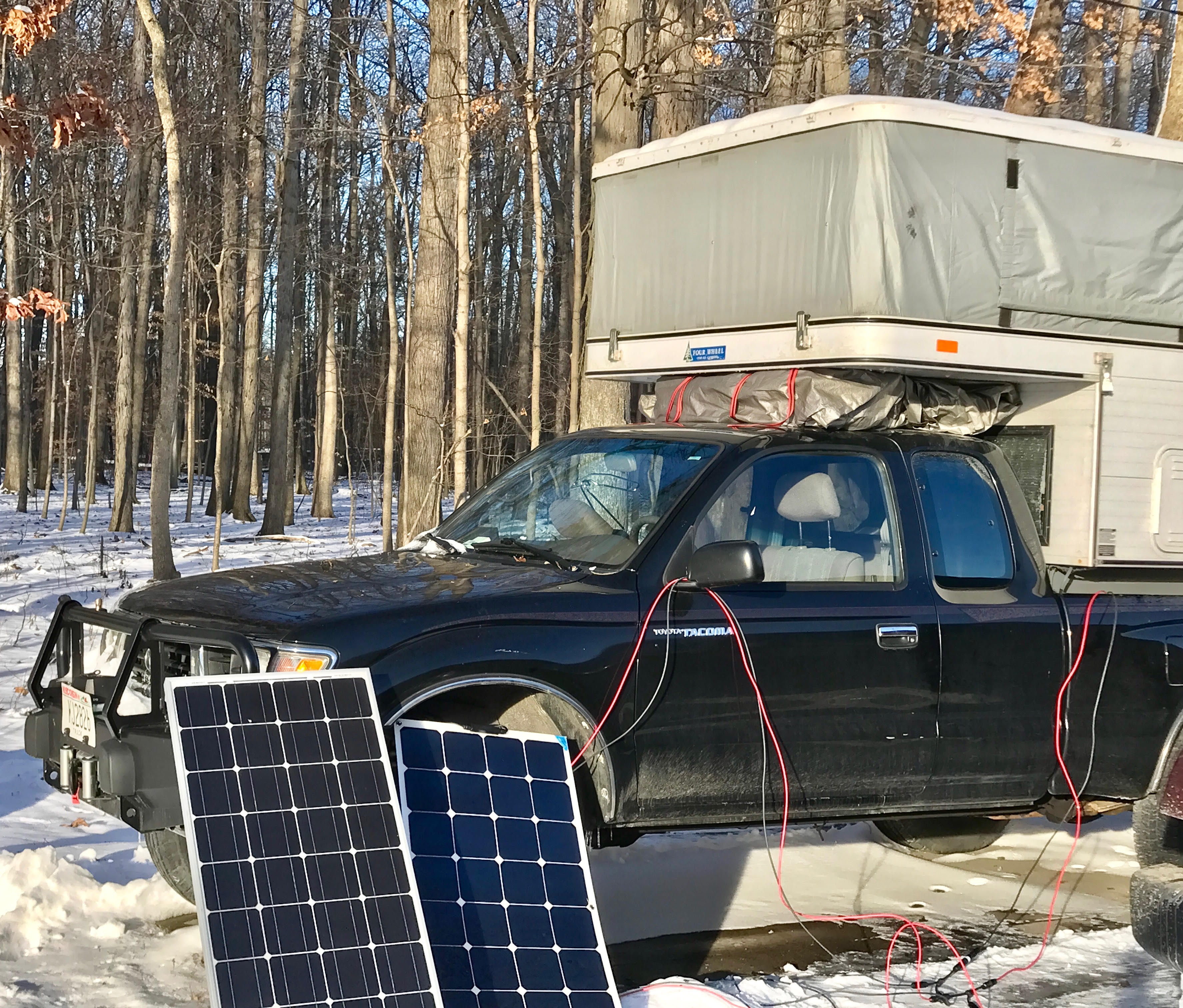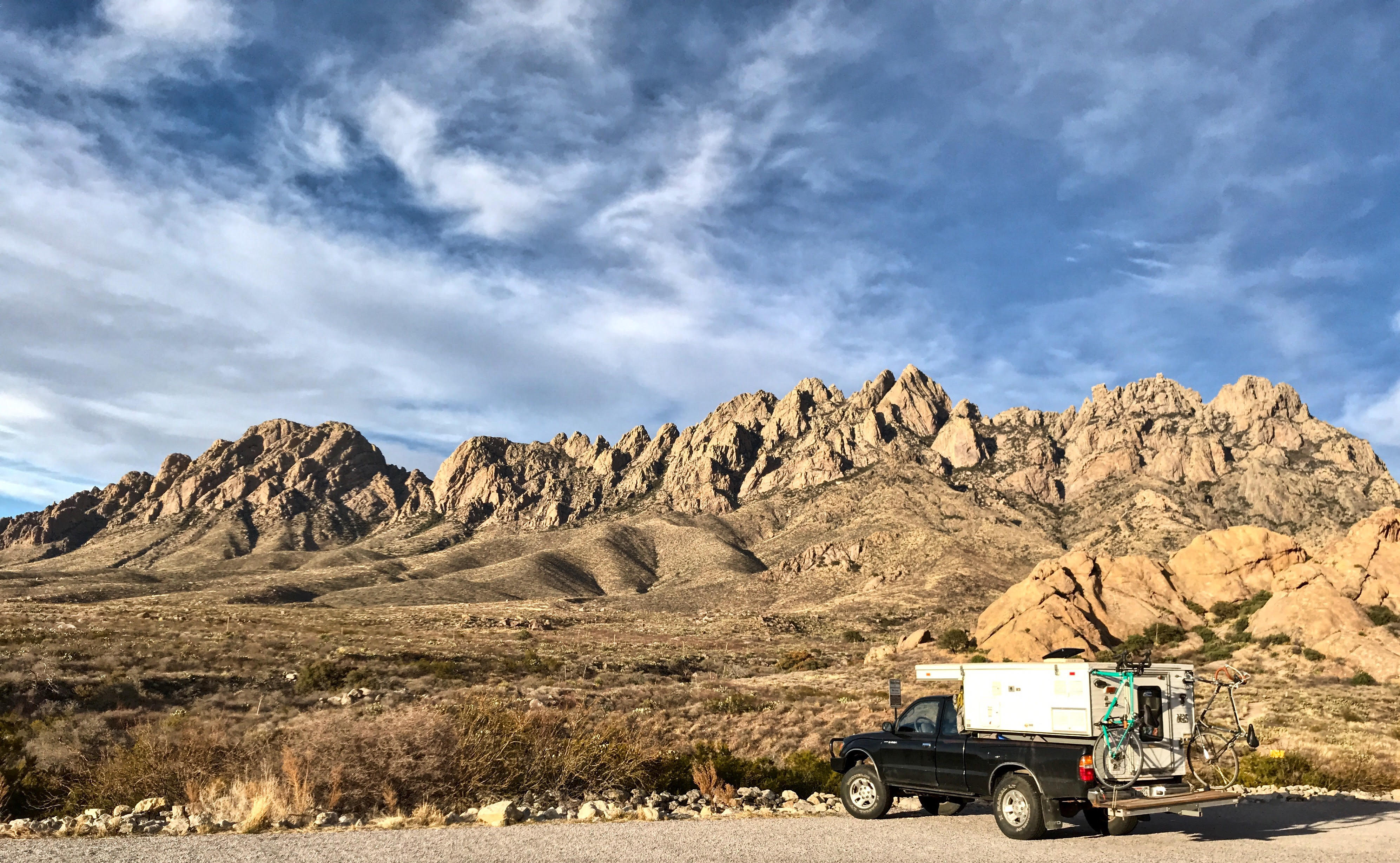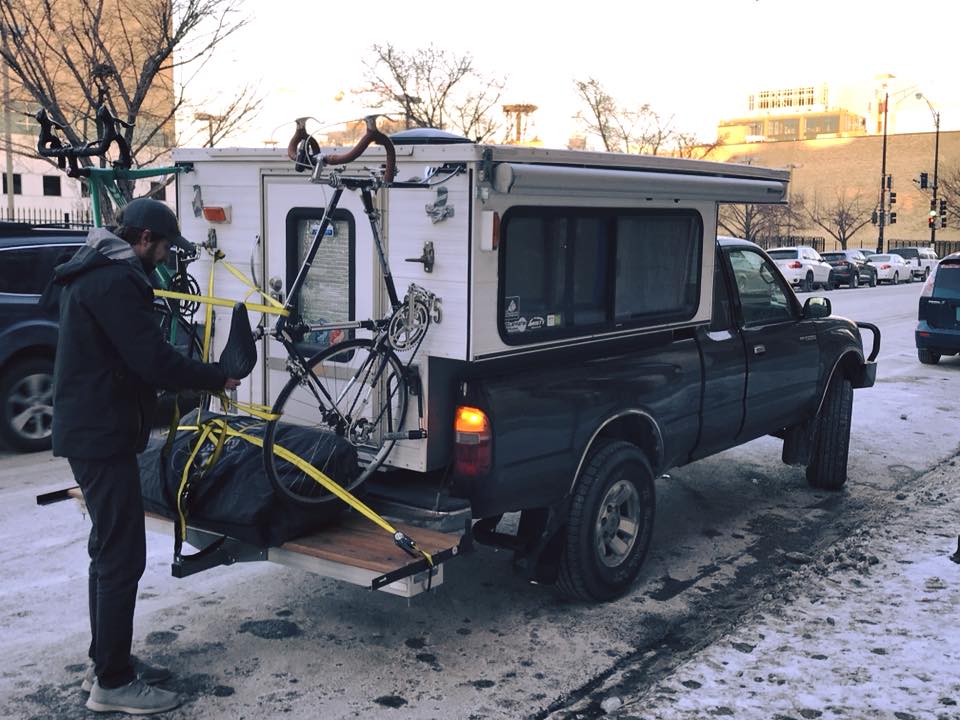How I downsized my life to the size of a truck camper.
Remember Chris Farley’s ‘Living in a van down by the river‘ skit? As a kid, I loved this and the iconic ‘Shitter’s Full‘ line from Christmas Vacation. I always thought these were absurd scenarios one would never hope to be in. Fast-forward 15 years, and I’m willingly giving up my Chicago lifestyle (and enormous wardrobe) to live and work out of a truck camper… So what happened?
Why would anyone live out of a truck?
Until 2 years ago, I didn’t realize that people could live out of truck campers. Then I took a trip to the American southwest and lived out of a Jeep for 10 days. This opened my eyes to a whole new way of traveling – one that didn’t involve hotels, AirBNBs, or traditional comforts. At the risk of sounding cliche, this trip changed my perspective on life.
Soon after, my partner (Patrick) and I built our 5 year plans in which we each categorized travel as a top priority. We became determined to create a more flexible lifestyle that would allow us to travel more frequently. To me, this meant finding remote jobs and looking into short-term rentals. To Patrick, this meant looking into less traditional options, such as van/truck campers. Although I wasn’t initially sold on this idea, the more I looked into it, the more I liked it.
The most attractive aspect of this lifestyle is that it gives you complete freedom to live for any amount of time wherever you want. As an added bonus, it’s a more sustainable way to effect long-term travel since you aren’t flying or living in rentals full-time. It’s also one heck of a challenge. My wardrobe in Chicago lined the walls of my apartment. I wasn’t exactly a minimalist when it came to clothes. Although the process of downsizing has been daunting and a bit unenjoyable, I like the challenge of cutting back to bare necessities, and streamlining/simplifying my life as much as possible.
Where are you staying?
The current plan is to stay at a mixture of dispersed/boondock sites, paid campsites, AirBNBs, VRBOs, HomeAways, and friends’ places. For a comprehensive guide on getting started with camping – including lots of great info on where to stay – check out this wonderful Beginner’s Guide to Camping.
Dispersed / Primitive / Free Camping or Boondocking
Our original plan was to only stay at free campsites. We’ve abandoned this plan for 2 reasons: (1) We want to see a number of cities / areas on the east coast that don’t have many options for free camping (Asheville, Savannah, Miami, Florida Keys); and (2) Many of the places we’re going this winter are colder than we anticipated. Our goal is to do more dispersed camping as we head west toward the Rockies, in the Pacific Northwest, and in Canada and Alaska.
There are a number of options for free camping. You can boondock in almost all National Forests and BLM land, which is readily available in the West and Pacific Northwest. You can camp for a few nights at most Wal-Marts, sporting / camping stores (such as Cabela’s), and truck stops. Freecampsites.net is a great resource for finding free campsites. The National Park Service offers dispersed camping in some National Recreation Areas, such as the Gauley River, as well.
Learning points so far…
Route planning is time-consuming. The fact that we’re leaving in winter and need to work 40+ hours each week has further complicated it (i.e. We don’t want to be trapped working in a tin box in a national forest with no indoor shower or plumbing for long periods of time). Prioritizing your goals in advance helps simplify the process. For example – If your #1 concern is saving money, then search freecampsites.net and plan your route based on where you find free camping. If you’re more concerned about seeing certain cities or areas (this is our top priority for the first few months), then plan to pay for campsites and rentals at least some of the time.
How’d you maximize space?
If you’re trying to efficiently utilize space, walls and ceilings are your best friends. Here are some of the tactics we’ve employed so far…
Organize.it. This is a recent discovery, and lifesaver. If you want a plethora of unique storage solutions that save space, spend time exploring this site. I bought a truck cargo organizer that holds our hats, gloves, belts, and other accessory items; and a coat rack for car seats to hold our coats and sweatshirts.
Back Seat Clothes Bar & Space Maximizing Hangers. I managed to fit nearly 2 tubs of clothes onto 4 hangers that will hang in the truck cab. We built a clothes bar by cutting a broom rod to the right size, drilling holes in it, then threading wire through the holes. The bar hangs on the truck’s back seat hooks (you also can buy these from Organize.it or Amazon).
Hanging Shoe Organizer. We’re using a hanging shoe organizer to hold most of our towels, cords, cleaning cloths, entertainment, and other items.
Cargo Storage Nets. We bought 2 storage nets and attached them to the camper walls. These hold shoes, small appliances, and anything else we want to easily grab.
Hanging Toiletry Bag. All our toiletries are in this bag, which hangs above the camper door. It not only saves space, but is easy to take into bathrooms when needed.
Antimicrobial Tiny Travel Towels. We traded our large towels for these quick-dry antimicrobial towels that roll up small enough to fit in the shoe organizer. If you look online, you can almost always find small, travel versions of bulky items.
Norwex Cleaning, Face & Body Towels. These cloths are great. They’re antimicrobial face, body, and cleaning cloths that clean your body and disinfect surfaces without any water or cleaning products. They free up lots of space since no soaps or cleaners are required. They’re supposed to last a few years too.
Magnetic Spice Racks. We’re storing spices in magnetic spice racks. Unfortunately, our fridge isn’t magnetized, so we’ve stuck these to a metal ruler that we hung on the wall with heavy-duty velcro.
Utilizing the Space Between the Truck & Camper. We have a 50 lb inflatable kayak and 2 oars. We took the kayak out of its bag, wrapped it in a tarp and bungees, then inserted it between the Tacoma’s cab and the top of the camper. It fits snugly enough that it doesn’t require further fastening. The oars are attached via eye hooks and bungees in the space between the truck bed and camper frame.
Bike Hooks. We bought garage bike hooks and attached them to the back of the camper, above the deck. Our bikes hang vertically from these.
 Kayak fitted between camper and truck.
Kayak fitted between camper and truck.
Bike hooks on back of camper.
How’d you get rid of all your stuff?
This is the question I’m asked the most by everyone who’s interested in downsizing.
OfferUp, LetGo, Poshmark, Swap.com and Facebook Marketplace. These sites are essentially giant yard sales that help you sell your things. I relied mostly on OfferUp and Swap. A few things to note: You can sell just about anything through OfferUp, LetGo, and Facebook Marketplace. Poshmark and Swap are clothing-only (and they’re picky about which clothes they accept). I sent a 35 lb box of clothes to Swap (all hardly worn and purchased within the last 5 years), and they only accepted 10 or so items. It took 3 months for my clothes to be added to their site, and I’ve made under $20 so far. Once the clothes are on the site; it’s simple – Once they sell, you get an email notification and money is transferred into your connected account. However, don’t expect to make much money from it. OfferUp worked well for valuable items (TVs, cameras, musical instruments). For most other stuff, expect to make $30 or less. I ended up tiring of negotiating on low-priced items, and just donated most of them to Goodwill.
Goodwill. The Goodwill in Chicago has 90% of our stuff. Anything that wasn’t worth the effort of selling ended up there. What’s great about Goodwill is that they accept everything – including hangers, laundry baskets, towels, and undergarments. If they can’t sell it, they find a way to donate it to people in need, or responsibly recycle it (as much as possible). That said, I’ll acknowledge that Goodwill has received some bad press in recent years (example). We tried taking our things to Salvation Army instead, however we were told the ones in Chicago only accepted clothing. So, we ended up back at Goodwill.
Rebuilding Exchange (‘RX’). RX is a Chicago non-profit that diverts old building materials and furniture from landfills. I donated my foosball table to their charity auction, and donated some of our all-wood furniture for them to repurpose. Although it’s Chicago-only, I’m sure there are similar organizations in other communities.
Patagonia. We took advantage of Patagonia’s worn wear program and exchanged any Patagonia clothes that we didn’t need or didn’t wear often for store credit, or other items we needed.
Electronics Recycling. You can take any brand of small personal electronics (think: computers, tablets, cell phones, cameras, mp3 players, etc.) to either Apple, Goodwill, or Best Buy for recycling. The bonus is that, if you return Apple products to Apple, they pay you relatively well (I’ve made a little under $500 for returning phones, an iPad, and a MacBook Pro).
Book Recycling. There are a number of options for book and magazine donation (you can find most via Google). We had nearly 10 boxes of books (including all my law school books from 8 years ago), which we took to Half Price Books(‘HPB’). Similar to Swap and Poshmark, HPB will pay you a nominal amount for some books, but it’s tough to know which they will deem valuable. We made $60 off of ours, and HPB donated or recycled the rest, which was fine with me. All I cared about was keeping them out of a landfill. If you aren’t worried about making money, Better World Books will take any books in decent condition, and has donation drop-boxes all over the country.
Earth911.com- Recycling Near You. You can search for recycling centers near you via this site. We found a number of Batteries+Bulbs, Lowe’s, and Home Depot locations that accept CLF light bulbs for recycling (these contain a small amount of mercury, so they shouldn’t be thrown in the trash). You can enter terms and a zip code to search for any type of recycling center.
CD & DVD Recycling. We used CDRecyclingCenter.org to recycle our old CDs, DVDs, and their cases. It’s free to use; you simply print a label, then send in your items.
Friends & Family. We gave as much as we could to friends and family. We also are storing a few items we can’t part with at our parents’ places.
How’d you reduce the camper’s footprint?
There aren’t many fuel-efficient options in the camper/RV space. So, we did our best to make the camper as efficient as possible via the following modifications…
Solar Panels. We bought and installed 2 Renogy low-light solar panels. As long as we have some light each day, these panels can run the camper without an electric hookup (More posts on this to come…).
LED & Solar Lights. We replaced all light fixtures with LEDs, and bought a number of solar lights. Like the panels, as long as the solar lights get some sun during the day, they can run all night. We bought our solar lights on Amazon.
Water Filtration Unit. We bought a TastePure water filtration unit from Ace Hardware. Although we can’t filter and drink rain water, we can filter well or campground water to use for showering and drinking. This eliminates the need to buy bottled water.
Repurposing Materials. We repurposed old deck boards and an old metal mattress frame into a back deck for the truck (more videos and photos of this to come…). We repurposed our mattress pad into a bed topper, and we turned used outdoor trash cans into storage bins that are strapped on the back deck.
RMFW Aluminum Truck Camper. We bought the lightest truck camper we could find, which turned out to be a used, aluminum-frame Rocky Mountain Four Wheel Camper (we found it on Denver’s Craigslist). Our Tacoma’s gas mileage isn’t as bad as it could be since our camper is light, and we aren’t pulling a trailer or dirt bike (as we initially intended to) in an effort to reduce weight and improve gas mileage.
If you have any thoughts, ideas, or suggestions – please comment or reach out to lauren@travelsages.com!
This post has been adapted from a similar post on getreprint.com. View the original post here.




At age 70, I am planning my next adventure, recently divorced , I am planning 2 run my small design firm from my truck camper while I travel. I have the office set up and the camper with cameras and will be starting shortly on 10 day or two week trips. I still have a house and an acreage which I love & still will maintain while I finish it to eventually sell. Back in the 70s I lived off the grid in a small handmade cabin and later in a 22 passenger school bus through the worst winter in Iowa history with the future mother of my children and a dog and the cat. That’s spring we moved into a 48 passenger School Bus and commence to tear house down to get enough lumber to build a cabin . We had a cabin raising with different people showing up every day to help . I’ve done the outhouse, solar shower, wood Heat, corn cob fired cook stove, baths in farm ponds and it was some of the most magical time of my life. I’m not ready to go back to all of that but some of it. The truck camper had to have a toilet and a shower which mine does. Palomino 1251 pop up camper. I just finished all of the things at the office yesterday with program software cameras Etc. Doing our first remote this morning. I am truly excited, it’s what got me through a very ugly divorce. Back in the 70s 80s I hitchhiked a lot and used to tell people I could leave with a quarter and come back with $0.50. The concept is still valid but not the dollar figure. So soon in my rolling camper or as my niece calls it portable Command Center I will be hitting the road for my first Excursion away from home& the office. I have told my clients about it and they actually are kind of excited to be part of this. So as they used to say” Keep On, Keepin On”, ” Keep On Truckin”
Thank you for that awesome story! Be sure to keep us posted as you start your journey. None of our clients have had an issue with our lifestyle so far. It’s been a lot easier than we expected. Can’t wait to hear how it goes for you!